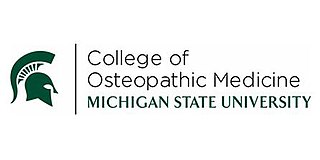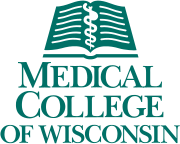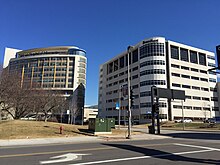
Marquette University is a private Jesuit research university in Milwaukee, Wisconsin. Established by the Society of Jesus as Marquette College on August 28, 1881, it was founded by John Martin Henni, the first Bishop of the diocese of Milwaukee, Wisconsin. Initially an all-male institution, Marquette became the first coeducational Catholic university in the world in 1909.

New York Medical College is a private medical school in Valhalla, New York. Founded in 1860, it is a member of the Touro University System.
The Association of American Medical Colleges (AAMC) is a nonprofit organization based in Washington, D.C. that was established in 1876. It represents medical schools, teaching hospitals, and academic and scientific societies, while providing services to its member institutions that include data from medical, education, and health studies, as well as consulting. The AAMC administers the Medical College Admission Test and operates the American Medical College Application Service and the Electronic Residency Application Service. Along with the American Medical Association (AMA), the AAMC co-sponsors the Liaison Committee on Medical Education (LCME), the accrediting body for all U.S. MD-granting medical education programs.

The Emory University School of Medicine is the graduate medical school of Emory University and a component of Emory’s Robert W. Woodruff Health Sciences Center. Emory University School of Medicine traces its origins back to 1915 when the Atlanta Medical College, the Southern Medical College (1878), and the Atlanta School of Medicine merged.

The Indiana University School of Medicine (IUSM) is a major, multi-campus medical school located throughout the U.S. state of Indiana and is the graduate medical school of Indiana University. There are nine campuses throughout the state; the principal research, educational, and medical center is located on the Indiana University–Purdue University Indianapolis (IUPUI) campus in Indianapolis. With 1,452 MD students, 203 PhD students, and 1,356 residents and fellows in the 2022–23 academic year, IUSM is the largest medical school in the United States. The school offers many joint degree programs including an MD/PhD Medical Scientist Training Program. It has partnerships with Purdue University's Weldon School of Biomedical Engineering, other Indiana University system schools, and various in-state external institutions. It is the medical school with the largest number of graduates licensed in the United States per a 2018 Federation of State Medical Boards survey with 11,828 licensed physicians.
Froedtert Hospital, located in Wauwatosa, Wisconsin, is a teaching hospital and a Level I adult trauma center, one of two such facilities in Wisconsin. Froedtert is the primary teaching affiliate of the Medical College of Wisconsin (MCW), where MCW students and residents receive their clinical education. Froedtert has 735 inpatient hospital beds. Froedtert is located on the Milwaukee Regional Medical Center grounds, which is a consortium of six health care institutions.

The Michigan State University College of Human Medicine (MSUCHM) is an academic division of Michigan State University (MSU) that grants the Doctor of Medicine (MD) degree, emphasizing patient-centered care and a biopsychosocial approach to caring for patients. Required courses at the college reinforce the importance of ethics and professionalism in medicine. In 2013, U.S. News & World Report ranked the college 46th for primary care. The college was also ranked for family medicine and rural medicine. More than 4,000 M.D.s have graduated from the college. Pre-clinical campuses are located on MSU's main campus in East Lansing, Michigan and in downtown Grand Rapids, Michigan, while the clinical rotations are at seven community campuses located throughout Michigan.
The University of Cincinnati Academic Health Center (AHC) is a collection of health colleges and institutions of the University of Cincinnati, Cincinnati, Ohio. It trains health care professionals and provides research and patient care. AHC has strong ties to UC Health, which includes the University of Cincinnati Medical Center and West Chester Hospital.

The State University of New York Upstate Medical University is a public medical school in Syracuse, New York. Founded in 1834, Upstate is the 15th oldest medical school in the United States and is the only medical school in Central New York. The university is part of the State University of New York (SUNY) system.

The Boston University Chobanian & Avedisian School of Medicine (CAMED), formerly the Boston University School of Medicine, is one of the graduate schools of Boston University. Founded in 1848, the medical school was the first institution in the world to formally educate female physicians. Originally known as the New England Female Medical College, it was subsequently renamed Boston University School of Medicine in 1873, then Chobanian & Avedisian School of Medicine in 2022. In 1864, it became the first medical school in the United States to award an M.D. degree to an African-American woman.

The University of Wisconsin School of Medicine and Public Health (UWSMPH) is a professional school for the study of medicine and public health at the University of Wisconsin–Madison. It is one of only two medical schools in Wisconsin, along with the Medical College of Wisconsin in Milwaukee, and the only public one.
The University of Arizona College of Medicine – Tucson, located in Tucson, Arizona, is one of three MD granting medical schools in the state of Arizona, affiliated with the University of Arizona. The University of Arizona College of Medicine – Phoenix was initially established as a branch campus in 2007, but became an independent medical school in 2012. The College of Medicine – Tucson campus is located at the University of Arizona Health Sciences (UAHS) center on the campus of the University of Arizona and is governed by the Arizona Board of Regents. Traditionally, the college accepted Arizona residents exclusively. However, beginning the 2009–2010 incoming class, the school changed its policy to allow for admission of "highly-qualified," non-residents.
Marshall B. Ketchum University is a private university focused on graduate programs in healthcare and located in Fullerton, California. MBKU expanded from the Southern California College of Optometry which was founded in 1904. The university was officially established as a multidisciplinary university with the addition of School of PA Studies in 2011 and College of Pharmacy in 2013. Along with Hope International University, the campus bookends the north and south sides of the Cal State Fullerton campus respectively.

The Michigan State University College of Osteopathic Medicine (MSUCOM) is one of the two public medical schools of Michigan State University, a public land-grant research university in East Lansing, Michigan. The college grants the Doctor of Osteopathic Medicine (D.O.) degree, as well as a DO-PhD combined degree for students interested in training as physician-scientists. MSUCOM operates two satellite campuses in Clinton Township and Detroit. The college is accredited by the American Osteopathic Association's Commission on Osteopathic College Accreditation (COCA) and by the Higher Learning Commission.
The University of Tennessee College of Medicine is one of six graduate schools of the University of Tennessee Health Science Center (UTHSC) in downtown Memphis. The oldest public medical school in Tennessee, the UT College of Medicine is a LCME-accredited member of the Association of American Medical Colleges (AAMC) and awards graduates of the four-year program Doctor of Medicine (MD) degrees. The college's primary focus is to provide practicing health professionals for the state of Tennessee.

Children's Wisconsin is a nationally ranked, freestanding, 298-bed, pediatric acute care children's hospital located in Milwaukee, Wisconsin. It is affiliated with the Medical College of Wisconsin and is a member of the Children's Wisconsin health system, one of two of the children's hospitals in the system. The hospital provides comprehensive pediatric specialties and subspecialties to infants, children, teens, and young adults aged 0–21 throughout the Wisconsin region. The hospital features an ACS verified level I pediatric trauma center, one of two in the state. Its regional pediatric intensive-care unit and neonatal intensive care units serve the region. The hospital also has a rooftop helipad for critical pediatric transport.

University at Buffalo School of Medicine and Biomedical Sciences, also known as Jacobs School of Medicine and Biomedical Sciences, is a public medical school in the city of Buffalo, New York at the University at Buffalo. Founded in 1846, it is one of the oldest medical schools in the United States and is the only medical school in Buffalo. It is part of the State University of New York (SUNY) system.














